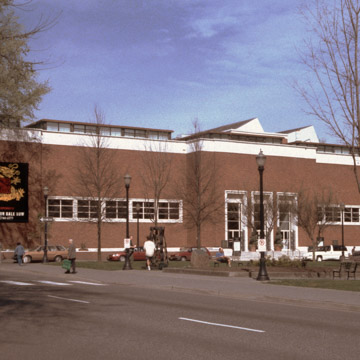Portland Art Museum 1219 Sw Park Ave Portland or 97205 United States
You are here
1932, Pietro Belluschi; 1939 expansion, Pietro Belluschi; 1970 expansion, Pietro Belluschi; 2000 renovation; 2005 expansion. 1219 SW Park Ave.
The Portland Art Museum was established past the Portland Fine art Association in 1892 as a education institution, ane that housed a collection accessible to those who wanted to study painting and cartoon. Accordingly, ane of the first purchases was a drove of plaster casts of Greek and Roman sculpture for utilize in the school's drawing classes. Henrietta Failing served as the museum's first curator, and was succeeded in 1909 by Anna Belle Crocker, a painter and nifty educatee of contemporary art movements, which was shortly reflected in the museum's drove.
The museum and art school were outset housed in the Portland Public Library, located in the city's business concern commune (it was later demolished and replaced past the Multnomah County Library). As the institution continued to grow, the museum lath voted to cock a purpose-congenital construction. In 1927, the board hired Portland's preeminent architect, Albert E. Doyle, but after Doyle'due south untimely death the following yr, his chief design assistant, Pietro Belluschi, took over the committee. Belluschi had trained nether painter Harry Wentz at the museum's fine art school, and was well acquainted with Crocker'southward focus on contemporary art. Although his architectural sensibility was shaped past Doyle'southward masterful historicism, he planned to update Doyle'southward original design, despite the fact that the edifice committee strongly desired a Georgian Revival building (much like Harvard'due south recently completed Fogg Art Museum). Belluschi asserted that the museum "should be designed from the within out, and that no expert interior practical characteristic be sacrificed for a faked external appearance." He as well observed that both skylights and windows posed several problems: not but the threat of leakage only also issues with glare and the limited wall space for paintings. Belluschi'south solution was overhead monitor daylighting, softened as necessary with venetians blinds—a solution possibly inspired by the Dulwich Flick Gallery (1812–1817, Sir John Soane).
The Portland Art Association acquired a 200-foot-square city block at Southwest Jefferson Street on the westerly border of several tree-lined blocks extending south from Southwest Salmon Street. To suit future growth, Belluschi placed the first stage of the museum complex (later on chosen the Ayer Wing) facing Southwest Park Avenue (so known equally Westward Park Street), ensuring a permanently unobstructed entry facade. The plan of this initial section featured two long galleries on the upper floor and smaller galleries below flanking a key entry vestibule that opened behind a slightly projecting center pavilion.
Belluschi modified the initial Georgian Revival exterior to a more stylized design. The building committee was initially resistant until Frank Lloyd Wright, who had recently lectured at the Academy of Oregon Schoolhouse of Architecture and Centrolineal Arts, commended Belluschi for his simple plan and "sensible modernistic exterior." The materials continued the symbolic link to Georgian classicism, with Flemish bond reddish brick walls and foam-colored travertine used in the lowermost water table, the window surrounds, the alpine triple-entry door surrounds, and especially in the broad abstracted "frieze" and modest "cornice." Belluschi afterwards wrote that the design was driven by the very limited budget, and hence there was no possibility of colonnades, an imposing k staircase, or "other expensive exercises." Past emphasizing the practical part of every component, using the finest materials, and "eliminating the more than transitory qualities of style," Belluschi believed he and his team had expressed the vital function of the structure in terms of an enduring essence. The Portland Art Museum remains one of the earliest modern museum buildings of its time, preceding New York'south celebrated modernist Museum of Modernistic Art by almost a decade.
As initially planned, later additions gradually filled the block. In 1937–1939, Belluschi congenital the dramatically skylit Solomon and Josephine Hirsch Fly for sculpture at the rear of the original structure, which doubled the museum'due south gallery infinite. Thirty years later, Belluschi designed the large Hoffman Wing (1967–1969) on the north stop, which housed classroom and studio infinite for the art school, an auditorium, sculpture mall, and a new vault for the collections; this fly was renovated in 2000 to include over 50,000 square feet of gallery space. In the early 1990s, the Portland Art Museum acquired the Masonic Temple (1924) direct to the north. At present known as the Mark Building, the museum renovated the vaguely Egyptian Revival structure to house its modernistic and contemporary fine art collection. The 141,000-square-foot facility opened in 2005 and boasts half dozen floors of exhibition space, a library, meeting spaces, ballrooms, and administrative offices.
References
Writing Credits
If SAH Archipedia has been useful to you, please consider supporting it.
SAH Archipedia tells the story of the United States through its buildings, landscapes, and cities. This freely available resources empowers the public with authoritative noesis that deepens their understanding and appreciation of the built environment. But the Society of Architectural Historians, which created SAH Archipedia with University of Virginia Press, needs your support to maintain the high-caliber research, writing, photography, cartography, editing, design, and programming that brand SAH Archipedia a trusted online resource available to all who value the history of place, heritage tourism, and learning.
Source: https://sah-archipedia.org/buildings/OR-01-051-0009

0 Response to "Portland Art Museum 1219 Sw Park Ave Portland or 97205 United States"
إرسال تعليق